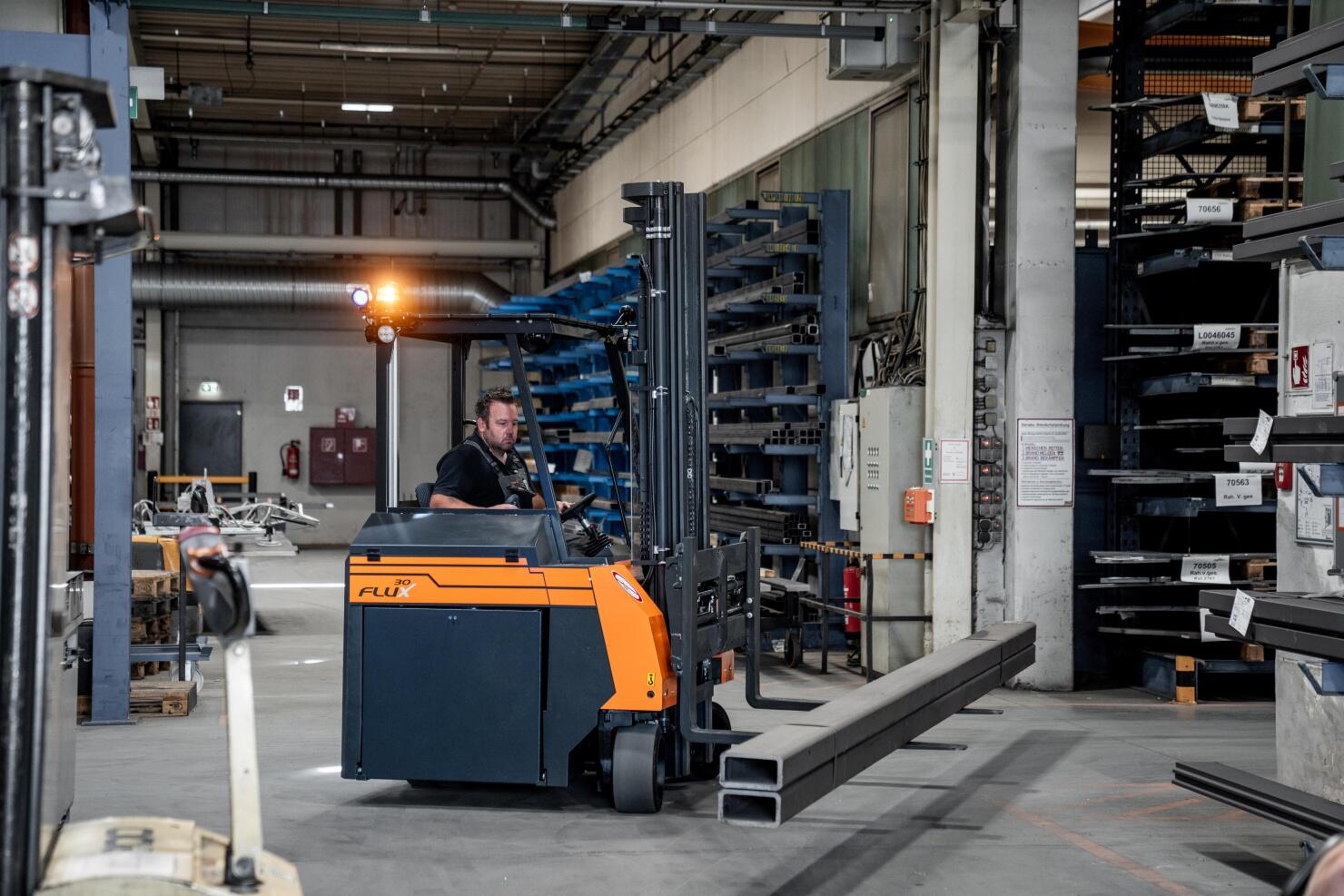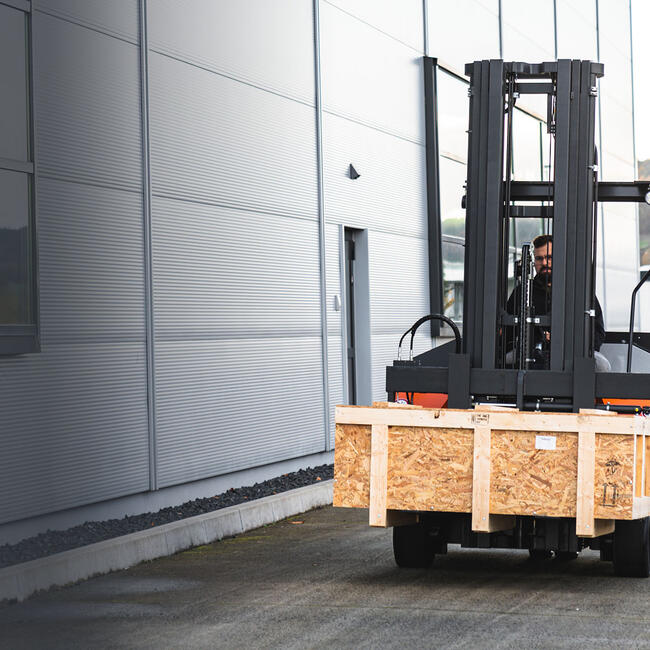Forklift - The classic truck
A forklift truck is a motorised industrial truck in which the lifting device is attached to the front of the vehicle and the driver's seat is oriented in the direction of travel. The trucks are available in different sizes and with different engines, as gas, diesel or electric forklift trucks. This means that the right forklift truck is available for every application and the most diverse payloads.
What is a forklift truck?
Forklifts are most commonly used in industry, which is why they are generally considered classic forklift trucks. Due to their design and the orientation of the driver's cab, the driver of such a forklift has his load constantly in view. The load is lifted via the lifting unit in front, whereby the factory-mounted forks are designed for transporting pallets in terms of their size and the distance between the forks. With special attachments, such as cages or snow removal equipment, forklifts can be used very flexibly.
The forklift construction
The term front loader applies to all forklifts whose lifting unit is located at the front of the industrial truck. Consequently, a farm loader can be a front loader just as much as a heavy all-terrain forklift or a compact electric forklift for internal transport. The lift unit consists of the lift mast and the fork carriage. The lifting of the load is implemented via the forks or via appropriate attachments such as cages. The horizontal and vertical movements of the fork carriage are carried out via a hydraulic system.
Usually, forklifts reach travel speeds of 20 km/h maximum. A key feature of compact forklifts is the number of wheels. There are forklifts with 3-wheels and forklifts with 4-wheel drive, which differ partly considerably in their respective driving and steering behavior. Chassis with 3 wheels are less tilt-resistant than 4-wheel trucks and are designed for lower payloads.
The essential components of forklifts at a glance:
- Frame and chassis
- Counterweight for stable driving behavior
- Drive axle and steering axle
- Lift mast with fork carriage and forks
- Driver's cab with steering wheel
What are the special features of forklift trucks?
Forklifts operate according to the counterweight principle, with the truck's own weight providing the counterweight. This principle ensures that the industrial truck does not tip over to the front when lifting heavy objects. As a result, large and heavy forklifts are capable of safely lifting and transporting weights of several tons. Various options exist for powering these trucks, such as gas, gasoline, diesel and electric. In forklifts, the engine is installed under the driver's cab. Thus, in addition to pure drive, it has another important function: The engine creates a low center of gravity in the overall design, which ideally supports the counterweight principle.
Areas of application of the forklift truck
Forklifts are used both indoors and outdoors. It should be noted that in enclosed halls and workshops, forklifts with electric drives are used in most cases. The reason for this is the avoidance of harmful exhaust gases. In outdoor areas, the preferred choice is for heavy-duty forklifts with LPG, gasoline or diesel drives. The most robust and strongest are propellant gas and diesel-powered rough terrain forklifts, which can move safely even in difficult terrain conditions such as mud, debris, slippery or inclines.
- Handling of goods
- Internal transport
- Sorting goods, picking
- Logistics
- Loading tasks of all kinds
The focus of forklifts in industry and commerce is on large transport volumes, which are later transported further by other material handling vehicles such as pallet trucks.
How do forklift trucks differ from sideloaders?
In the case of a sideloader, the driver's seat is either fixed facing the forks or flexibly rotatable. Since these trucks pick up any loads transverse to the direction of travel, they are designed for transporting long loads and logistics tasks in premises with narrow transport paths. The space a forklift truck needs to work is dictated by its dimensions and the loads that extend beyond them. As soon as it comes to handling long bulky loads or maneuvering in narrow spaces, forklifts therefore quickly reach their limits.
Pros and cons at a glance
Advantages:
- flexible all-round forklift truck
- a suitable forklift drive with the required performance values is available for every work task
- the driver always has the transported goods in view
- low steering angle
Disadvantages:
- comparatively large turning circle
- depending on the design (e.g. 3-wheel or 4-wheel, electric drive), stability and load capacity are limited
Was ist beim Einsatz von Frontstaplern noch zu beachten?
Um einen motorbetriebenen Gabelstapler bedienen zu dürfen, benötigt der Fahrer einen Staplerführerschein, kurz Staplerschein genannt. Ebenso muss eine umfangreiche Einweisung am konkreten Staplermodell erfolgen. Da sämtliche Waren und Güter stets vorn transportiert werden, kommt es bei voluminösen Lasten schnell zu Blickfeldeinschränkungen. In diesen Fällen ist beim Transport und Umschlag besondere Vorsicht geboten. Um die Forderungen des Gesetzgebers zu erfüllen und die vom Hersteller angegebene Lebensdauer zu erhalten, müssen die vorgegebenen Service- und Wartungsintervalle stets eingehalten werden.
HUBTEX Forklift
More and more companies are reaching their limits with conventional forklifts. Perhaps the available space is no longer sufficient or the handling of long loads is inefficient and unsafe. For such cases we have developed the 2-in-1 forklift FLUX. The FLUX is a compact forklift truck with the ability to be used as a forklift and sideloader. Pallets as well as long loads can be moved efficiently and safely with it.

As a 2-in-1 forklift, the FLUX moves long loads like a sideloader.

